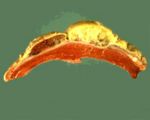Difference between revisions of "Traumatic Reticulitis"
Jump to navigation
Jump to search
| Line 20: | Line 20: | ||
# Localised peritonitis | # Localised peritonitis | ||
# Local fibrinous adhesions | # Local fibrinous adhesions | ||
| − | # Penetration of the diaphragm and pericardium resulting in pericarditis. Pericardium is enormously thickened with oedema, and purulent fluid containing fibrin clots accumulates in the sac giving “bread and butter heart” - classical traumatic reticulitis.[[Image:traumatic pericarditis.jpg|thumb|right|150px|Traumatic pericarditis (Courtesy of BioMed Image Archive)]] | + | # Penetration of the diaphragm and pericardium resulting in [[Pericarditis|pericarditis]]. Pericardium is enormously thickened with oedema, and purulent fluid containing fibrin clots accumulates in the sac giving “bread and butter heart” - classical traumatic reticulitis.[[Image:traumatic pericarditis.jpg|thumb|right|150px|Traumatic pericarditis (Courtesy of BioMed Image Archive)]] |
# Penetration of the heart itself resulting in myocarditis and endocarditis | # Penetration of the heart itself resulting in myocarditis and endocarditis | ||
# Penetration of the lungs and pleura resulting in pneumonia and pleurisy | # Penetration of the lungs and pleura resulting in pneumonia and pleurisy | ||
Revision as of 08:46, 2 July 2010
| This article has been peer reviewed but is awaiting expert review. If you would like to help with this, please see more information about expert reviewing. |
- Due to their unselective feeding habits, cattle may injest a variety of foreign bodies.
- Heavier metallic objects consumed become lodged in the reticulum, and may penetrate the reticular wall under the influence of the continuous reticular movements.
Clinical
- Signs are often vague, but adult cattle show abdominal pain with hunched backs and grunting on the "bar test".
Pathogenesis
- Cattle cannot spit out metallic agents (e.g. screws, nails, pieces of wire, bottle tops)once in their mouths, and so ingest them.
- Objects often become sharper in the reticulum due to reticular juices.
- Object penetrates through reticulum wall due to reticular movements. This is enhanced in pregnancy and parturition.
Pathology
- Pathological changes depend on the direction of penetration; this is usually in an anterior-ventral direction.
- Pyogenic bacteria escape from the reticulum, causing one or more of the following:
- Localised peritonitis
- Local fibrinous adhesions
- Penetration of the diaphragm and pericardium resulting in pericarditis. Pericardium is enormously thickened with oedema, and purulent fluid containing fibrin clots accumulates in the sac giving “bread and butter heart” - classical traumatic reticulitis.
- Penetration of the heart itself resulting in myocarditis and endocarditis
- Penetration of the lungs and pleura resulting in pneumonia and pleurisy
- Liver and splenic abscesses
- Large abscesses in the dorsal part of the liver may erode into posterior vena cava to produce thrombosis.
- Very thick-walled, pus-filled abscesses form around points of penetration, which may be multiple.
- The foreign object may be found in one of these abscesses, or free in the reticular lumen
